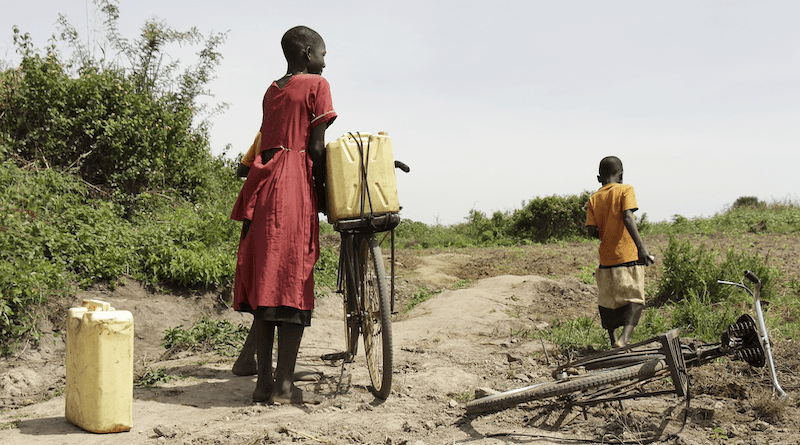Dr Farah Hegazi, Dr Kyungmee Kim and Dr Karen Meijer

Amid the profound challenges of fragile and conflict-affected settings, development and peacebuilding actors do commendable work improving the quality and accessibility of one of the most critical resources for human life and livelihoods: clean water. Their work has undoubtedly helped to defuse intercommunal tensions over scarce water resources and has perhaps prevented many localized conflicts from breaking out.
This year’s World Water Day, which falls on 22 March, has as its theme ‘Leveraging water for peace’. This theme underlines the fact that water management projects can have wider social benefits, improving troubled relations between communities and providing valuable experience of cooperation and peaceful negotiation. This blog examines what it takes to consolidate these gains and thus contribute to sustainable, long-term peace.
Water management and its complex relationship with peace
Water scarcity can increase tensions and conflict risk. The Pacific Institute’s Water Conflict Chronologylists 285 conflicts in which water issues have acted as a trigger since 2020. For example, in 2021members of the Cameroonian Massa and Musgum ethnic groups clashed with Arab Choas over theownership of a water point, killing at least 22 people and displacing hundreds. In 2023, Afghan and Iranian forces came to blows over a cross-border water rights dispute, leading to multiple deaths and injuries, while fighting between Oromo and Somali pastoralists erupted in Ethiopia over water and grazing land, leaving seven people dead.
In theory, reducing water scarcity should reduce conflict risk. Technical solutions that increase supply and decrease demand can mitigate competition that might otherwise increase the risk of conflict.
However, peace is complex. A purely technical fix may have limited impact on conflict risk, especially in the long term. Water scarcity itself does not cause conflict; conflict only happens if water scarcity exacerbates existing social, cultural, political or economic fault lines. Thus, successful and sustainable peace efforts must address these root causes. Otherwise, the next time there is a problem involving water access, conflict could return.
Another problem with purely technical fixes is that they can often be perceived as favouring one group more than another. This can even raise rather than reduce tensions, which could potentially spill over into violence.
Inclusivity, participation and water management
Water-management interventions in fragile and conflict-affected settings, whether carried out by water actors or peacebuilding actors, increasingly address social inclusion and participation. They involve localstakeholders, not least the water users, in negotiating and even co-developing water-management solutions that align with their different needs in a way that all perceive as fair.
A promising example of this kind of approach took place in the Dosso region in Niger, an area wherethere has been conflict between farmers and herders linked to agricultural expansion into transhumance corridors. As part of the recent Frexus project implemented by German development agency GIZ, local stakeholders, including both farmers and herders, jointly analysed the links between water, livelihoods and conflict. This helped them to find peaceful resolutions to community-level conflicts and reduced tensions around the establishment of a groundwater pumping station. The stakeholders were also able to meet the project implementers individually, which allowed them to raise sensitive issues, which were then discussed during a group workshop.
Institutionalizing good water governance
Such inclusive, stakeholder-driven water management projects can certainly contribute to peace. But the solutions they identify may be short-lived, addressing a specific, localized problem. Furthermore, challenges such as the effects of climate change or population growth may undermine the gains over time.
Projects that aim to build peace through improved water management should keep in mind the longer term. Mechanisms to manage water resources and resolve water disputes need to be institutionalized in ways that help them to endure beyond the project lifecycle and to deal with new challenges.
Projects also need to take into account the wider governance context. Providing access to sufficient clean water is, ultimately, the responsibility of the state. So, too, is ensuring that disputes over water resources are settled fairly and justly. However, weak and mistrusted state authorities are a common phenomenon in fragile and conflict-affected settings. Sometimes public resistance to water management reforms and projects is linked to the perceived illegitimacy of state authorities (or other actors) involved in them.
Individual water management projects cannot expect to transform public perceptions of these actors or to radically strengthen weak government agencies and utilities. But they can often help to do so and thus bolster the sustainability of any peace and water-management gains. Wherever possible, they should ensure a role and a level of responsibility for state authorities.
Leveraging water for sustainable peace
World Water Day 2024’s theme is timely and essential, drawing attention to and advocating for the role that water management can play in peacebuilding. The experiences and hard work of the broad range of practitioners already involved in improving water management in ways that reduce the risk of conflict deserve to be more widely recognized
However, to move from water for peace to water for sustainable peace, and to ensure the water management challenges of the future can be managed effectively and peacefully, projects need to institutionalize their gains, ideally through accountable authorities and utilities.
No comments:
Post a Comment